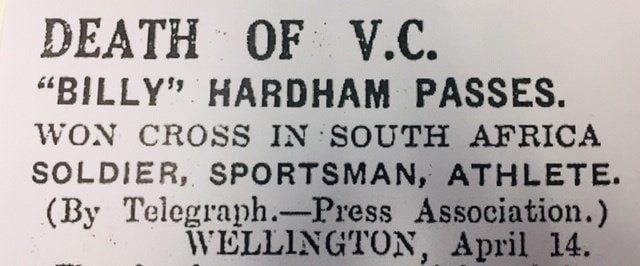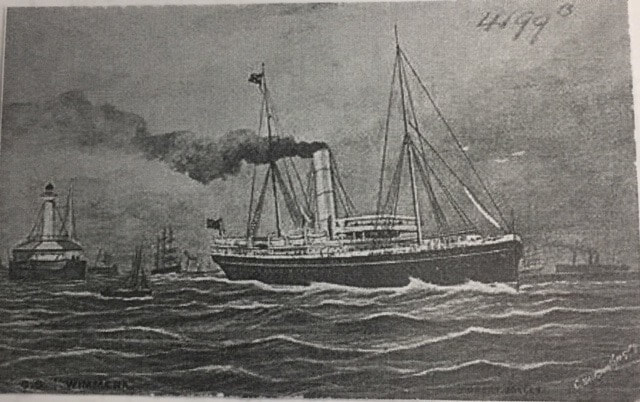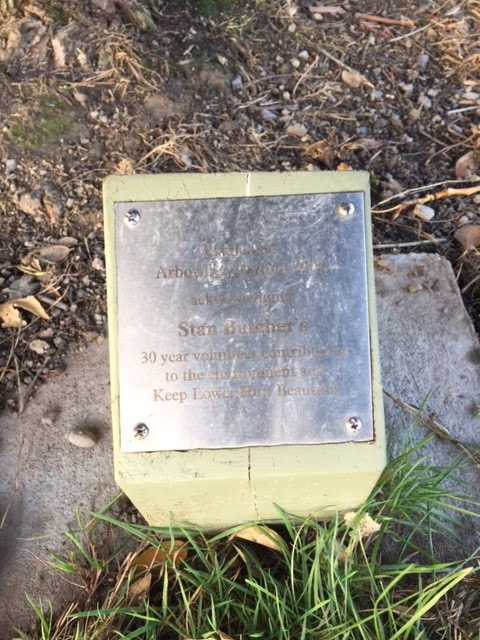|
One hundred and twenty years ago tomorrow, on January 28, 1901, Wellingtonian Major William James Hardham, serving in the Boer War, saw one of his soldiers fall wounded and his horse killed.
So he acted. Hardham rode into heavy fire, dismounted and put the wounded Trooper John McRae, of Masterton, on his own horse and ran alongside to get him to safety. Hardham became the first New Zealand-born man to be awarded the Victoria Cross. He was an extraordinary soldier and man. Born in Otaki in 1876, Hardham was educated and grew up in Wellington going to Mount Cook School. He made his debut as a rugby player for Wellington in 1897. Hardham became a farrier, blacksmith and part-time soldier. He volunteered to serve in the Boer War. Posted to the 4th Contingent, nicknamed the Rough Riders, he was just 24 when he and his company were ambushed by about 20 Boer soldiers while on patrol near Naauwpoort - and he performed the heroic rescue of McRae. Hardham was presented his Victoria Cross by George, Prince of Wales, who was visiting South Africa at the time. Two months later he was discharged and he returned home. He volunteered again, although he did not return to South Africa. Back in New Zealand as a civilian he was a keen rugby player and was part of the Wellington team that won the Ranfurly Shield off Auckland in 1904. In all, Hardham represented Wellington more than 50 times. He became part of the rugby administration with the Wellington Rugby Football Union. A competition trophy, the Hardham cup, played for in Wellington senior club rugby, is named for him. Hardham volunteered to return to service in World War One serving as a captain in the Wellington Mounted Rifles regiment of the New Zealand Expeditionary Force in Egypt and at Gallipoli. The regiment was not part of the initial landings at Gallipoli arriving later, on May 12 (without their horses). During an attack on Anzac Cove the company fended off attackers. During a battle for No.3 Post Hardham was seriously wounded in the chest and a hand. He returned to New Zealand and while he recovered he was the Commandant of Queen Mary Hospital in Hanmer Springs. He re-enlisted returning to active service in Palestine in 1918 but after poor health he was discharged at the end of the war at the rank of Major. After loyally serving in the armed forces for years he returned to Wellington where he worked for The Dominion newspaper and the Public Works department. Hardham died in 1928, aged 51, of stomach cancer and is buried at the Karori Soldiers Cemetery. John McRae, the man Hardham rescued, was promoted to Lieutenant the following year. He remained in South Africa after the war, married and had a family. He died there in 1963 aged 87.
0 Comments
On 22 March 1931, 13 residents of the Horowhenua town of Foxton set off for an autumn boating and picnic excursion on the Manawatu River - only eight made it back alive. Tragically, the five dead came from just two families. By all accounts the weather was favourable on the morning the party, all residents of Union Street, set out on the recently refurbished, 30-foot (9-metre), kauri launch Nina. The boat was owned by Foxton Borough Council waterworks engineer William Neville, who was aboard with his wife and three children. Also aboard were flax worker Frederick Henry Henricksen, his wife Ellen, their children Elsie, Edna and Cyril, and neighbour 18-year-old Manly Symes, who was to become the hero of the day. The party was completed by launch’s skipper, Hape Hakaraia and his 10-year-old son Charlie. The party left Foxton at about 10am and sailed upstream towards Palmerston North. Nearing lunchtime, about 20 kilometres from Foxton, someone spotted some wild blackberries bushes growing along the riverbank. Hape was urged to pull the Nina over so the ripening berries could be picked and added to the lunch table. Once the baskets were full, the picnickers got back into the launch to sail a few hundred metres upstream to a small beach on the other side of the river where a fire could be made. As the women went about preparing the lunch fare aboard the boat, tragedy struck. About 100 metres from their destination, in the middle of the strongly-flowing river, the Nina hit a large submerged object. The boat’s hull was torn off, sinking it within seconds. Most of the picknickers were thrown into the water. The life belts floated away down the river out of reach of the struggling party. Ellen Henricksen, her daughter Edna and Connie Neville managed to cling to one of the remaining belts, but fearing it would not hold all three safely, Mrs Henricksen let go, sacrificing her life. Frederick Henricksen, who could not swim, was also thrown into the water and drowned.
Hape, Charlie, Jimmie Neville and Manley Symes swam for the bank. During the swim, Hape suffered a seizure and dragged Charlie under the water with him. Both drowned. Manly Symes made it to the shore, but twice jumped back into the water pulling Jimmie, Edna and Connie to safety. Still clinging to the boat, were William Neville and his wife, who was also holding young Cyril Henricksen. William grabbed his wife by the coat and started swimming for the riverbank, but his feet became entangled in some ropes. Mrs Neville sank beneath the water and lost consciousness letting go of little Cyril. By the time William reached the shore and managed to pull his almost lifeless wife from the water Cyril was gone. The township of Foxton mourned the tragic loss of lives. Hape Hakaraia, born in Otaki, had lived in the town for many years. He was a noted singer, performing as the lead in many concerts in the area. Frederick Henricksen was born in Grovetown in the South Island, the child of Danish immigrants. His wife Ellen was the daughter of one of Foxton’s earliest settlers Abraham King. Frederick and Ellen Henricksen and Cyril are buried next to Abraham King at Foxton Cemetery. Hape Hakaraia and Charlie are buried in Otaki in the Rangiatea Churchyard. But from the tragedy love blossomed. Three years later, two of the survivors, the hero of the day, Manly Symes, and Frederick and Ellen’s oldest daughter Elsie Henricksen, married. If you want to find out if your family has interesting stories we can help. The steamer Wimmera travelled through the night of June 25, 1918, her passengers on their way from Auckland to Sydney, asleep.
On board were 76 passengers and 75 crew. They woke suddenly as the ship vibrated violently. The Wimmera had struck an enemy mine, laid by the German merchant raider SMS Wolf. The huge explosion had blown away part of the stern and some cabins and broken the main shaft and put the dynamo out of action. Under a moonlit night, Captain Herbert James Graham Kell ordered the lifeboats launched. For a short time the ship remained stable and passengers were quickly put into a heavy sea. All the boats managed to make it away from the sinking ship which suddenly rose by the bow for her death plunge, sending up a huge geyser of water. Captain Kell had remained on the ship. For a while the lifeboats made good progress. Four landed near Tom Bowling Bay near New Zealand's North Cape. More landed at Taemaro east of Mangonui. One boat was swept along ending up at Kaiamou Beach. Under wartime censorship, little was initially able to be published. Later, lists of the survivors and fears that the last boat had been lost were in newspapers. Eight months before the voyage a warning had been issued about a moored enemy mine that had been swept off the coast of Australia. Captain Kell had seen that warning. A court of inquiry found Captain Kell had taken that too lightly. Twenty-six had died in the disaster. In 2010 the wreck of the Wimmera was believed to have been found using advanced underwater sonar developed by the company of Auckland electronics expert Mike Hodson north of Cape Reinga. Captain Kell’s resting place is now known. New Zealand has many lost or hidden cemeteries. We’re going to see which ones we can find.
Lower Hutt’s High St is one of the busiest. Most people driving into town, however, never know they are driving past one of the original graveyards and the original settlers buried there. The Knox Presbyterian Church, just down from Hutt Hospital used to be the site of the Blackbridge Cemetery - now there is a garden and two memorial stones. The church, which began in 1840, opened its first building in 1858 and burials took place in the late 1800’s. But after difficulty maintaining the cemetery it was decided to remove all the headstones and monuments and create a small garden with a memorial. No bodies were moved. Many of the immigrants were from Scotland, but there were others from India, England, Ireland and France. Buried there are Alexander Dalgety and members of his family. Dalgety, who arrived in 1841, was one of the original purchasers of the church ground. George Stratton was found dying on the ground near the hospital in pouring rain and at an inquest he was found to have died of “apoplexy by exposure to cold and rain.” Most of his family are also buried there, including his wife Sarah. Others include Peter Bruce, involved in setting up a public school in Taita, stood for the Hutt River Board several times, and is named on a plaque in the church as one of the founders. Robert McCulloch and his wife Euphemia who arrived in 1852. Robert helped set up the Taita school. The couple, along with their daughter Catherine are named as founders of the congregation. Also there are George McIlvride, blacksmith, farrier and district licensing commissioner and Rev John Hope, who formerly opened the church in 1890. The last recorded burial was in 1913. However a recent memorial stone also includes those connected with the church who had permission to have their ashes scattered there. Do you know about a “hidden” cemetery. Let us know in the comments and we’ll see what we can find out. In fact, it’s 92,500 natives planted on Matiu/Somes Island, turning it from a barren rat-infested island back into a haven for native species.
So it’s fitting that under a little tree in picturesque Avalon Park in Lower Hutt is a little plaque commemorating his life. A life member of Lower Hutt Forest and Bird, he played a vital role in the 30-year project to replant the island. By 2006 he had estimated the number of trees he had planted to be 92,500. With the planting of native bush came the chance to return Tuatara to the island in 1998. He received the Queen’s service medal in 2006 for his environmental work. Stan became interested in native bush growing up as a young boy in Nelson. The native fuchsia trees entranced him. Stan was inspired by the stories of Johnny Appleseed - John Chapman in real life - an 18th century American nurseryman who distributed and sold apple tree seedlings to pioneers through Ohio and Indiana. He left school intending to become a surveyor. He married his childhood sweetheart then decided to go into teaching. He trained at Wellington College in the 40’s and was principal for Korokoro and Epuni schools but it was once he retired, that his fascination with nature led him to begin the projects that would define his life. Although he had been a paying member of Forest and Bird since 1941, he never went to a meeting until 1981, only a few days after he retired. The next day he was asked to join the council and then went to a planning meeting about Somes Island. Since then he has raised hundreds of little trees in his back garden, many destined for their new life on the island. Stan died in 2006 aged 94 and was cremated. He truly left a living legacy. |
AuthorFran and Deb's updates Archives
May 2025
Categories |






 RSS Feed
RSS Feed